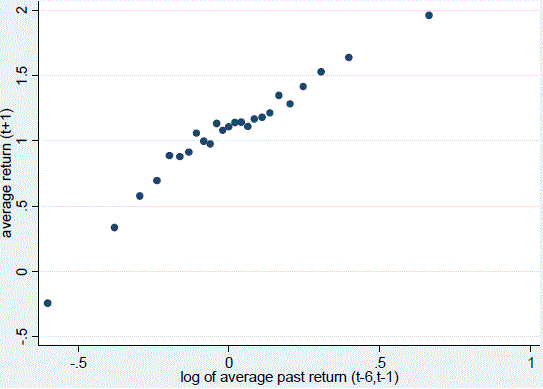Why does some prior research find that double sorts, first on some non-return variable and then on past returns, enhance momentum strategy performance? Are the enhancements truly distinct from momentum, or do they just pick higher momentum stocks? In their December 2010 paper entitled “One Effect or Many: Sources of Momentum Profits and Pitfalls of Double-Sorting”, Pavel Bandarchuk and Jens Hilscher investigate why sorting stocks first on some firm/stock characteristic and then on past returns elevates momentum profits. Specifically, they examine in several ways the relationship between each of size (market capitalization), return R-squared (similar to idiosyncratic volatility), turnover (12-month average), age (years listed), stock price, illiquidity (average absolute weekly return divided by weekly dollar volume) and credit rating and past returns to investigate the incremental profits of combining each with momentum. They use the logarithm of six-month past return with skip-month (effectively, a five-month return) to measure momentum. They calculate average future returns based on equal weighting and monthly portfolio reformation. Using weekly and monthly data for a broad sample of U.S. stocks spanning 1964 through 2008 (3,187 stocks per month on average), they find that:
- The relationship between momentum and future returns is positive and systematic (see the chart below). Over the entire sample period, a hedge portfolio that is long (short) the half of stocks with the highest (lowest) past returns generates an average monthly gross return of 0.55%. Selecting the stocks with the highest and lowest 10% (4%) of past returns boosts average monthly gross return to 1.6% (2.2%).
- Sorting on idiosyncratic volatility (measured with weekly data over the past year) rather than past returns produces similar results, because high-volatility stocks are more likely to be high-momentum stocks. The average monthly gross return for the fifth of stocks with the highest (lowest) lagged idiosyncratic volatility is 2.0% (close to zero).
- Stocks with extreme momentum (top and bottom tenths of past returns) have on average 35% lower market capitalization, 15% lower return R-squared, 82% higher turnover, 39% lower time listed, 26% lower price, 96% lower liquidity and lower credit rating than those in the middle of the past return distribution (middle 20%).
- For most of these characteristics, momentum profits increase systematically across sorted fifths. For example, average monthly gross momentum hedge returns (high minus low quintiles) are 0.53%/1.17%/1.34% for the fifths of stocks with the largest /middle/smallest market capitalizations. This kind of double-sort enhancement is largest (smallest) for credit rating (R-squared).
- Double quintile sorting first on firm/stock characteristics and then on past returns tends to generate portfolios with more extreme past returns. Adjusting for the effect on past returns nearly eliminates the benefit of double sorting. Idiosyncratic volatility appears to be the common connection between characteristics and past returns.
- Specifically, a momentum-only strategy comparable to the the quintile double sorts (long the 4% of stocks with the highest past returns and short the 4% with the lowest) generates an average monthly gross return of 2.2%, beating or matching all double-sort strategies.
The following chart, taken from the paper, plots average monthly gross percentage returns for 25 portfolios sorted on the logarithm of past returns from six months prior through one month prior, equally weighted and reformed monthly over the entire sample period. In general, past winners (high past returns) outperform past losers (low past returns), and this outperformance tendency is highly systematic. In other words, the more extreme the past returns, the higher the average monthly gross profitability of a momentum strategy.
As described above, double sorting first on various firm/stock characteristics and then on past returns essentially just selects stocks with higher past returns.
Note that stocks with extreme past returns may have low liquidity, complicating exploitation of momentum on a net basis.

In summary, evidence indicates that presorting on other firm/stock characteristics can enhance momentum strategy returns, but such double sorting is no better than a simple momentum strategy based on especially extreme past returns.
Note that:
- Return calculations in this study are gross, not net.
- The momentum strategies described likely involve high portfolio turnover, such that trading frictions would substantially dent gross profits. Moreover, as noted above, the highest momentum stocks may bear the highest trading frictions. High-turnover strategies are especially problematic for individuals, whose stock-by-stock positions tend to be small.
- Stocks with high momentum also tend to be volatile, such that high average monthly returns may not translate to similarly attractive cumulative returns.